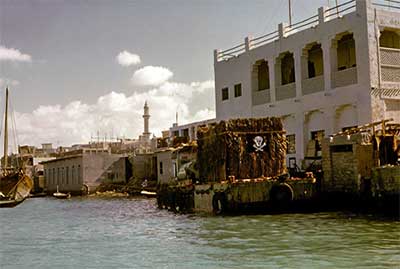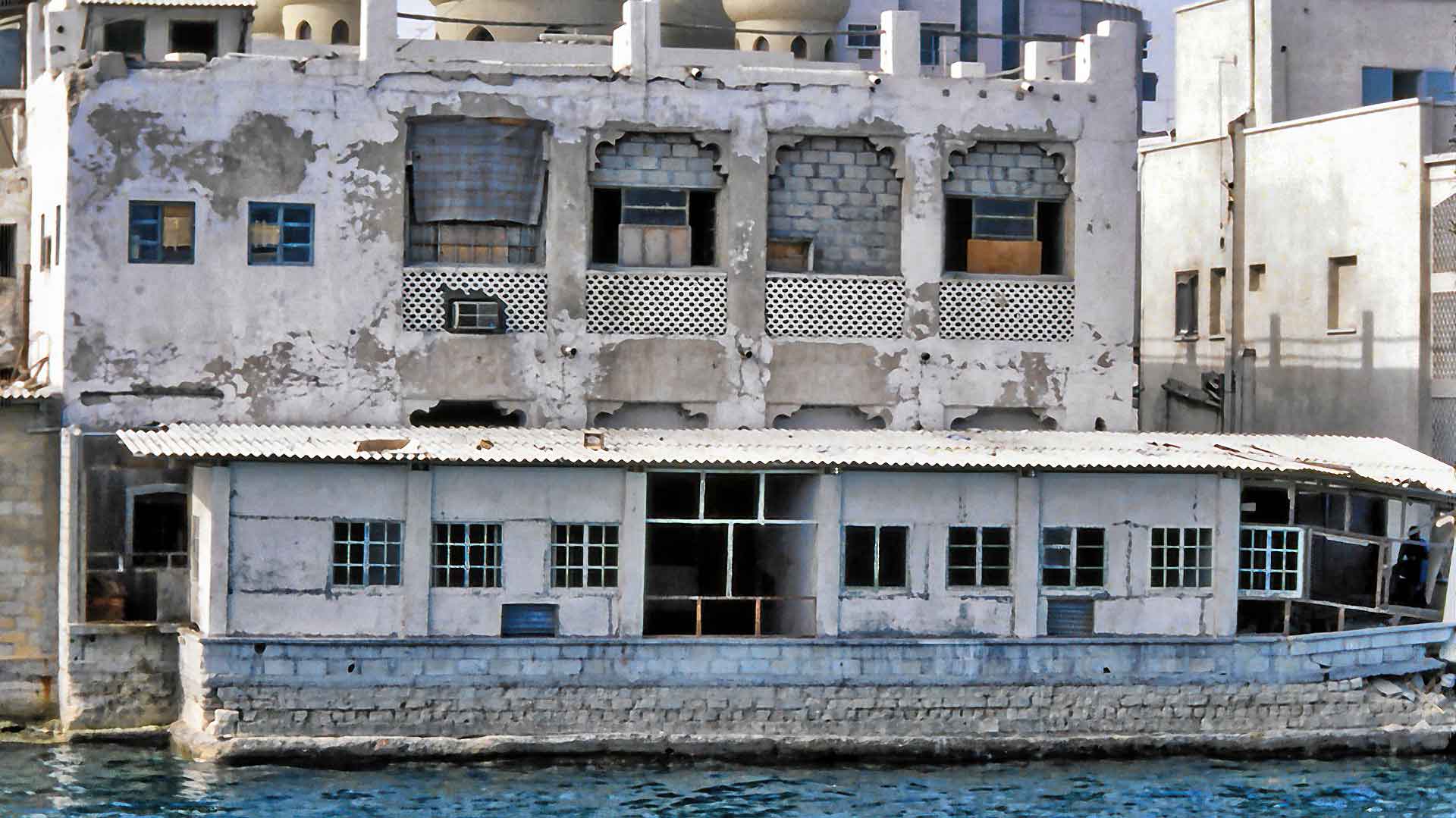
Bayt Al Wakheel is located inside Dubai Textile Soukh
Some Traders sell to the local market
Further into the Soukh are the International Traders
These import textiles from around the World then re-export around the Gulf
Dubai Soukh 1960s

Bayt Al Wakeel is one of Dubai's oldest buildings.
Bayt Al Wakeel was built in 1935 from local mud and coral with Mangrove Poles imported from East Africa as roof support
Its original purpose was as a Company Office and Residence for Gray Mackenzie and Company.
By late 1970s, Bayt Al Wakeel fell into disrepair.
Now restored, Bayt Al Wakeel functions as a Creekside restaurant.

Bayt Al Wakeel was built as a shipping office in 1935 by Iranian mason Saji Mohd Kukhardi using gatch, a form of mud brought from Dubai Creek.
Located in Dubai Soukh and adjacent to Dubai Creek, Bayt Al Wakeel was subsequently leased by Gray Mackenzie and Company. Gray Mackenzie were first appointed as licensed shipping agents in Dubai in 1891.They were Agents for many of the Shipping Lines calling at Dubai back then.
They officially leased this office building from the then Ruler of Dubai His Highness Sheikh Saeed Bin Maktoum Al Maktoum.
Bottom floor was used as a shipping office with the manager and his family living on the upper floor.
.Bayt Al Wakheel unique had the largest living area in Dubai at that time. Eleven feet wide was the common room width because that was the dimension of the Eat African mangrove poles used for construction of the flat mud roof. Bayt Al Wakeel builder used a different design, making a centre pillar, using chandals (‘poles”in Arabic), and making the living area 22 feet wide. Dubai had no running water or electricity in 1935. Manager would start his 3-kilowatt generator to illuminate a 200-watt bulb atop a flagpole on the building's roof. This was intended to be a beacon to guide ships.
Passengers sailing to Basra or Bombay assembled on the ground floor then were ferried to embark their ship anchored offshore.
Lower floor served as an Office with easy access to a Creekside jetty where Gray Mackenzie's boats were moored. Ocean going liners anchored offshore from Dubai to discharge their cargoes and passengers before Port Rashid was built. As a Ship's Agent, Gray Mackenzie required quick and easy access to the Ships' Captain so an Agent's Boat was always available at Bayt Al Wakheel's jetty. Similarly Merchants had to have easy access to Bait Al Wakeel to arrange discharge, clearance and delivery of their cargoes. All the documentation involved was processed by Gray Mackenzie Clerks on this lower floor.

In 1950, George Chapman and his family arrived in Dubai and took up residence in the upper floor of Bayt Al Wakheel.
While the accommodation was not palatial, it did provide a balcony with an outlook over Dubai Creek. Mr George Chapman and his family lived "above the shop" for many years. Mr Chapman was a close Confidante of Sheikh Rashid bin Saeed Al Maktoum, then Dubai's Ruler, and involved in Dubai's offshore water trade. In 1971, he established Dubai Port Services, a company set up to manage and operate the newly built Port Rashid.
In 1964, Gray Mackenzies' commercial operations transferred to new Al Ras offices on newly reclaimed land on Deiraside where it is still today. Bayt Al Wakeel continued to be used to house junior Gray Mackenzie management staff until around 1972. (Image by L Hejze)
We lived in Al Fahidi Street in 1971. Bayt Al Wakheel was barely 10 minutes' walk away.
With no modern telecommunications, ship's crews relied on watching movies screened on board using film projectors. These films were exchanged between different ships via the Ship's Agent in each Port. Gray McKenzie’s junior management staff had the job of cleaning these films before transfer to a new ship. We were invited to Bayt Al Wakheel to assist the junior staff member living there with cleaning these films on the promise of seeing a movie followed by a fish and chip supper.
Those enjoyable evenings came to an end as Dubai expanded and there were more comfortable places for Gray Mackenzie's staff to live.
Bayt Al Wakheel then became accommodation for the increasing number of Labourers arriving in Dubai
Thus began Bayt Al Wakheel's deterioration and eventual abandonment.

Dubai Municipality restored and remodelled Bayt Al Wakeel as an historic building.
Later local Businessman Mr Ahmed Al Rafi took over the building, completed the refurbishment
He then opened the Bayt Al Wakeel as a Dubai Creek Side Restaurant.
The landing stage where the Agent's boats used to leave to visit the Cargo Ships anchored offshore now provides a unique place to dine and watch the abras and dhows on Dubai Creek.
In 2005, my wife and I spent a holiday in Dubai and visited Bayt Al Wakheel for lunch.
Our Water asked if this was the first time we had been to Bayt Al Wakheel
We explained our connection with the building and commented on its restoration.
Waiter told us Mr Rafi was in the building and he would speak to him.
Shortly Mr Rafi joined us. We were able to tell him of times spent in this building over 40 years ago
while Mr Rafi told us of his efforts to restore Bayt Al Wakheel.
A memorable moment of Dubai as it used to be!Len Chapman